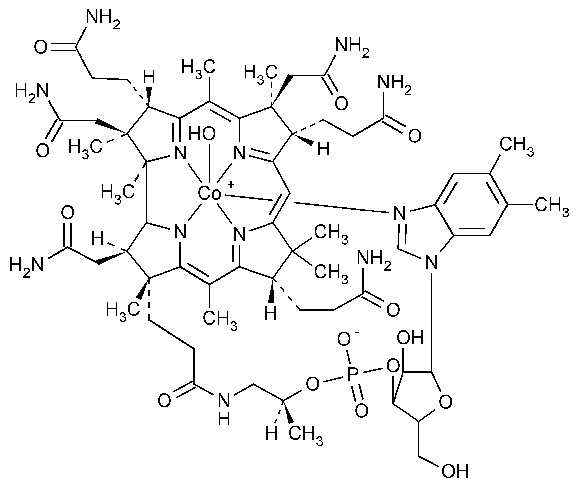Hydroxocobalamin
Cobinamide,dihydroxide,dihydrogen phosphate (ester),mono(inner salt),3¢-ester with 5,6-dimethyl-1-a-D-ribofuranosyl-1H-benzimidazole.
Cobinamide dihydroxide dihydrogen phosphate (ester),mono(inner salt),3¢-ester with 5,6-dimethyl-1-a-D-ribofuranosylbenzimidazole [13422-51-0].
»Hydroxocobalamin contains not less than 95.0percent and not more than 102.0percent of C62H89CoN13O15P,calculated on the dried basis.
Packaging and storage—
Preserve in tight,light-resistant containers,and store in a cool place.
Identification—
A:
The visible absorption spectrum of the solution,prepared for measurement of the absorption as directed under pH-dependent cobalamins,exhibits maxima at 426±2nm,516±2nm,and 550±2nm.
B:
Fuse a mixture of about 1mg of Hydroxocobalamin and about 50mg of potassium pyrosulfate in a porcelain crucible.Cool,break up the mass with a glass rod,add 3mLof water,and boil until dissolved.Add 1drop of phenolphthalein TS,and add 2Nsodium hydroxide dropwise until a pink color appears.Add 0.5g of sodium acetate,0.5mLof 1Nacetic acid,and 0.5mLof nitroso Rsalt solution (1in 100):a red or orange-red color appears immediately.Add 0.5mLof hydrochloric acid,and boil for 1minute:the red or orange-red color persists.
pHá791ñ:
between 8.0and 10.0,in a solution (2in 100).
Loss on drying á731ñ—
Dry it at a pressure below 5mm of mercury at 100 for 2hours:it loses between 14.0%and 18.0%of its weight.
for 2hours:it loses between 14.0%and 18.0%of its weight.
pH-dependent cobalamins—
pH4.0Buffer—
Dissolve 2.61g of sodium acetate and 20.5g of sodium chloride in 5.25mLof glacial acetic acid and sufficient water to make 1500mLof solution,and mix.
pH9.3Buffer—
Dissolve 23.8g of sodium borate and 402mg of boric acid in sufficient water to make 1500mLof solution,and mix.
Procedure—
[NOTE—Perform the following test in subdued light.]Transfer about 40mg of Hydroxocobalamin,accurately weighed,to a 25-mLvolumetric flask,dissolve in carbon dioxide-free water,dilute with carbon dioxide-free water to volume,and mix.Transfer 1.0-mLportions of this solution to each of two glass-stoppered test tubes.To one of the tubes,designated B,add 3.0mLof pH4.0Buffer,and mix.To the other tube,designated U,add 3.0mLof pH9.3Buffer,and mix.Determine the absorbance of solution U,in a 1-cm cell,at the wavelength of maximum absorbance at about 550nm,with a suitable spectrophotometer,using solution Bas the blank.Calculate the percentage of pH-dependent cobalamins,as hydroxocobalamin,by the formula:
(100,000A)/(19.66W),
in which Ais the absorbance of solution U,and Wis the weight,in mg,of Hydroxocobalamin taken:the content,calculated on the dried basis,is between 95.0%and 102.0%.
Limit of cyanocobalamin—
Cyanocobalamin tracer reagent,Cresol-carbon tetrachloride solution,Butanol-benzalkonium chloride solution,and Alumina-resin column—
Prepare as directed under Cobalamin Radiotracer Assay á371ñ.
Procedure—
Transfer about 50mg of Hydroxocobalamin,accurately weighed,to a 25-mLvolumetric flask,dissolve in water,dilute with water to volume,and mix.Transfer 5.0mLof this solution to a glass-stoppered,50-mLcentrifuge tube,and add 5.0mLof Cyanocobalamin tracer reagentand 15mLof Cresol-carbon tetrachloride solution.Insert the stopper,shake gently,centrifuge,carefully remove the upper,aqueous layer by aspiration,and discard the aspirated liquid.Add 25mLof 5Nsulfuric acid,insert the stopper,shake gently,centrifuge,and remove and discard the upper,aqueous layer.Repeat the washing with additional 25-mLportions of the 5Nsulfuric acid until the acid wash is colorless (six to eight washings),and discard the acid washings.Add Cresol-carbon tetrachloride solutionas necessary during the acid washings to maintain the volume of this phase at not less than 10mL.Wash this solution successively with two 10-mLportions of saturated dibasic sodium phosphate solution and one 10-mLportion of water,and discard all of the aqueous washings.Proceed as directed for Procedureunder Cobalamin Radiotracer Assay á371ñ,beginning with “To the washed extract add 30mLof a mixture of 2volumes of Butanol-Benzalkonium Chloride Solutionand 1volume of carbon tetrachloride.”
Calculation—
Calculate the cyanocobalamin content,in µg,of the Hydroxocobalamin taken by the formula:
R(CS/CU)(AU/AS),
in which Ris the quantity,in µg,of cyanocobalamin in the portion of the Standard solution taken;CSand CUare the corrected average radioactivity values,expressed in counts per minute per mL,of the Standard solution and test solution,respectively;and AUand ASare the absorbances,determined at 361nm,of the test solution and the Standard solution,respectively:the limit,calculated on the dried basis,is 5.0%.
Assay—
Cyanocobalamin tracer reagent,Cresol-carbon tetrachloride solution,Phosphate-cyanide solution,Butanol-benzalkonium chloride solution,and Alumina-resin column—
Prepare as directed under Cobalamin Radiotracer Assay á371ñ.
Assay preparation—
Transfer about 40mg of Hydroxocobalamin,accurately weighed,to a 2000-mLvolumetric flask,dissolve in and dilute with water to volume,and mix.Transfer 25.0mLof this solution to a beaker,add 5.0mLof Cyanocobalamin tracer reagent,and proceed as directed for Assay Preparationunder Cobalamin Radiotracer Assay á371ñ,beginning with “Add,while working under a hood,5mg of sodium nitrite.”
Procedure—
Proceed as directed for Procedureunder Cobalamin Radiotracer Assay á371ñ.Calculate the quantity,in µg,of C62H89CoN13O15Pin the Hydroxocobalamin taken by the formula:
(1346.36/1355.37)(R)(CS/CU)(AU/AS),
in which 1346.36and 1355.37are the molecular weights of hydroxocobalamin and cyanocobalamin,respectively;Ris the quantity,in µg,of cyanocobalamin in the portion of the Standard solution taken;CSand CUare the corrected average radioactivity values,expressed in counts per minute per mL,of the Standard solution and test solution,respectively;and AUand ASare the absorbances,determined at 361nm,of the test solution and the Standard solution,respectively.
Auxiliary Information—
Staff Liaison:Lawrence Evans,III,Ph.D.,Scientist
Expert Committee:(DSN)Dietary Supplements:Non-Botanicals
USP28–NF23Page 975
Phone Number:1-301-816-8389
